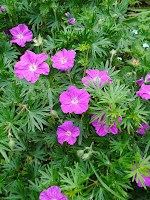I love to see flowering plants trailing over dry stone walls. There are a variety of plants suitable for this situation but the three plants I have trailing over my dry stone wall are Arabis, Aubrieta and Saponaria. All three are flowering at the moment.

Arabis caucasica is a perennial which grows to 9 inches high and spreads to about 24 inches. It has grey/green leaves and pure white flowers are produced from February until June. It can be a bit invasive as it is fast growing, so give it a bit of space to spread. The grey/green foliage is attractive even after the flowers are done. It prefers a well drained soil in partial shade. Cut back hard after flowering has finished and propagate by lifting and dividing established plants in September. Arabis caucasica was introduced into Britain from Southern Europe in 1798.
 .
.Aubrieta deltoidea is a mat forming perennial plant growing about 4 inches high and spreading about 18-24 inches. There are several varieties in varying shades of red, lilac and purple. They are all attractive colours but I prefer the purple which is a particularly vibrant colour. Aubrietas look stunning trailing over dry stone walls and flower profusely between March and June. Lightly trim the flowering stems when the flowers have finished. No other pruning is required. They can be propagated by dividing and replanting in September. A well drained soil and sunny position is preferred.
The Aubrieta was discovered by a botanical expedition sent by the French King Louis XIV. The botanical artist Claude Aubriet was part of the expedition and the plant was named after him. It is native to mountain regions from Sicily to Iran.

Saponaria ocymoides is a vigorous prostrate perennial which produces bright pink flowers from early summer. It will grow in any fertile garden soil in sun or partial shade. Like Arabis and Aubrieta it can be propagated by dividing and replanting established plants in the autumn. Another variety of Saponaria is the upright perennial Saponaria officinalis, also known as Soapwort, which has red, pink or white flowers and can grow to 3 feet tall. It is known as Soapwort due to its soapy qualities. If the leaves of this plant are swirled around in water a considerable lather can be achieved. The Romans used the suds as a water softener. It is believed that the Soapwort was originally collected by Crusaders in the 13th century when they were travelling home across the mountains of south west Asia and Europe. As recently as the 20th century its properties of cleansing softness were a recognised part of the treatment and conservation of old and precious tapestries.
 I also grow Geranium sanguineum (commonly known as bloody Crane's-bill) at the front of the border. This has larger bright magenta flowers and only grows to about 6 - 9 inches tall, but spreads to 18 inches making it a good ground cover plant. Geraniums grow in any ordinary well drained garden soil and will thrive in sun or partial shade. As with most perennials they can be propagated by dividing the plants and replanting them between September and March. Some of the taller varieties may need some support, especially in exposed sites.
I also grow Geranium sanguineum (commonly known as bloody Crane's-bill) at the front of the border. This has larger bright magenta flowers and only grows to about 6 - 9 inches tall, but spreads to 18 inches making it a good ground cover plant. Geraniums grow in any ordinary well drained garden soil and will thrive in sun or partial shade. As with most perennials they can be propagated by dividing the plants and replanting them between September and March. Some of the taller varieties may need some support, especially in exposed sites. 





 .
.
